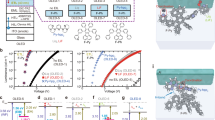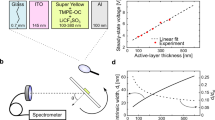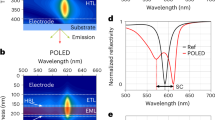Abstract
Determining the precise shape of the emission profile across the thickness of the active layer in organic light-emitting diodes is of importance for device optimization and assessing the validity of advanced device models. We present a comprehensive method for accurately measuring the shape of the emission profile, the intrinsic spectrum of emitting dipoles and the emitting dipole orientation. The method uses a microcavity light outcoupling model, which includes self-absorption and optical anisotropy, and is based on the full wavelength, angle and polarization resolved emission intensity. Application to blue (polyfluorene-based) and orange-red (NRS-PPV) polymer organic light-emitting diodes reveals a peaked shape of the emission profile. A significant voltage and layer thickness dependence of the peak positions is observed, with a demonstrated resolution better than 5 nm.
This is a preview of subscription content, access via your institution
Access options
Subscribe to this journal
Receive 12 print issues and online access
$209.00 per year
only $17.42 per issue
Buy this article
- Purchase on Springer Link
- Instant access to full article PDF
Prices may be subject to local taxes which are calculated during checkout






Similar content being viewed by others
References
D'Andrade, B. W. & Forrest, S. R. White organic light-emitting devices for solid-state lighting. Adv. Mater. 16, 1585–1595 (2004).
Sun, Y. et al. Management of singlet and triplet excitons for efficient white organic light-emitting devices. Nature 440, 908–912 (2006).
Schwartz, G., Pfeiffer, M., Reineke, S., Walzer, K. & Leo, K. Harvesting triplet excitons from fluorescent blue emitters in white organic light-emitting diodes. Adv. Mater. 19, 3672–3676 (2007).
Jeon, S. O., Yook, K. S., Joo, C. W. & Lee, J. Y. Highly efficient single-layer phosphorescent white organic light-emitting diodes using a spirofluorene-based host material. Opt. Lett. 34, 407–409 (2009).
Reineke, S. et al. White organic light-emitting diodes with fluorescent tube efficiency. Nature 459, 234–239 (2009).
Gustafsson, G. et al. Flexible light-emitting diodes made from soluble conducting polymers. Nature 357, 477–479 (1992).
Wang, G.-F., Tao, X.-M. & Wang, R.-X. Flexible organic light-emitting diodes with a polymeric nanocomposite anode. Nanotechnology 19, 145201 (2008).
D'Andrade, B. W. et al. Realizing white phosphorescent 100 lm/W OLED efficacy. Proc. SPIE 7051, 70510Q (2008).
Lu, M.-H. & Sturm, J. C. Optimization of external coupling and light emission in organic light-emitting devices: modeling and experiment. J. Appl. Phys. 91, 595–604 (2002).
Neyts, K. Simulation of light emission from thin-film microcavities. J. Opt. Soc. Am. A 15, 962–971 (1998).
Bulović, V. et al. Weak microcavity effects in organic light-emitting devices. Phys. Rev. B 58, 3730–3740 (1998).
Chen, X.-W., Choy, W.C.H. & He, S. Efficient and rigorous modeling of light emission in planar multilayer organic light-emitting diodes. J. Displ. Technol. 3, 110–117 (2007).
Nowy, S., Krummacher, B. C., Frischeisen, J., Reinke, N. A. & Brütting, W. Light extraction and optical loss mechanisms in organic light-emitting diodes: influence of the emitter quantum efficiency. J. Appl. Phys. 104, 123109 (2008).
Malliaras, G. G. & Scott, J. C. The roles of injection and mobility in organic light emitting diodes. J. Appl. Phys. 83, 5399–5403 (1998).
Wan, W. M. V., Friend, R. H. & Greenham, N. C. Modelling of interference effects in anisotropic conjugated polymer devices. Thin Solid Films 363, 310–313 (2000).
Kim, J.-S., Ho, P. K. H., Greenham, N. C. & Friend, R. H. Electroluminescence emission pattern of organic light-emitting diodes: implications for device efficiency calculations. J. Appl. Phys. 88, 1073–1081 (2000).
Granlund, T., Pettersson, L. A. A. & Inganäs, O. Determination of the emission zone in a single-layer polymer light-emitting diode through optical measurements. J. Appl. Phys. 89, 5897–5902 (2001).
Leger, J. M. et al. Thickness-dependent changes in the optical properties of PPV- and PF-based polymer light emitting diodes. Phys. Rev. B 68, 054209 (2003).
Roberts, M. Optical modeling and efficiency optimization of P-OLED devices. Proceedings of the Organic Electronics Conference and Exhibition '06 1 (2006).
Ruhstaller, B. et al. Optoelectronic OLED modeling for device optimization and analysis. SID Symposium Digest of Technical Papers 38, 1686 (2007).
Gather, M. C., Flämmich, M., Danz, N., Michaelis, D. & Meerholz, K. Measuring the profile of the emission zone in polymeric organic light-emitting diodes. Appl. Phys. Lett. 94, 263301 (2009).
Coehoorn, R. et al. Measurement and modelling of carrier transport and exciton formation in blue polymer light emitting diodes. Proc. SPIE 6192, 61920O (2006).
Markov, D. E. & Blom, P. W. M. Exciton quenching in poly(phenylene vinylene) polymer light-emitting diodes. Appl. Phys. Lett. 87, 233511 (2005).
Van der Vaart, N. C. et al. Towards large-area full-color active-matrix printed polymer OLED television. J. Soc. Inf. Disp. 13, 9–16 (2005).
Greiner, H. & Martin, O. J. F. Numerical modelling of light emission and propagation in (organic) LEDs with the Green's tensor. Proc. SPIE 5214, 248–259 (2004).
Kahn, R. U. A., Bradley, D. D. C., Webster, M. A., Auld, J. L. & Walker, A. B. Degradation in blue-emitting conjugated polymer diodes due to loss of ohmic hole injection. Appl. Phys. Lett. 84, 921–923 (2004).
De Kok, M. M. et al. Modification of PEDOT:PSS as hole injection layer in polymer LEDs. Phys. Stat. Sol. A 201, 1342–1359 (2004).
Van Mensfoort, S. L. M., Vulto, S. I. J., Janssen, R. A. J. & Coehoorn, R. Hole transport in polyfluorene-based sandwich-type devices: quantitative analysis of the role of energetic disorder. Phys. Rev. B 78, 085208 (2008).
Van Mensfoort, S. L. M., Billen, J., Vulto, S. I. J., Janssen, R. A. J. & Coehoorn, R. Electron transport in polyfluorene-based sandwich-type devices: quantitative analysis of the role of energetic disorder and electron traps. Phys. Rev. B 80, 033202 (2009).
Becker, H., Burns, S. E. & Friend, R. H. Effect of metal films on the photoluminescence and electroluminescence of conjugated polymers. Phys. Rev. B 56, 1893–1905 (1997).
Yang, C.Y, Hide, F., Diaz-Garcia, M. A., Heeger, A. J. & Cao, Y. Microstructure of thin films of photoluminescent semiconducting polymers. Polymer 39, 2299–2304 (1998).
Cao, Y., Parker, I. D., Yu, G., Zhang, C. & Heeger, A. J. Improved quantum efficiency for electroluminescence in semiconducting polymers. Nature 397, 414–417 (1999).
Wilson, J. S. et al. Spin-dependent exciton formation in π-conjugated compounds. Nature 413, 828–831 (2001).
Segal, M., Baldo, M. A., Holmes, R. J., Forrest, S. R. & Soos, Z. G. Exciton singlet–triplet ratios in molecular and polymeric organic materials. Phys. Rev. B 68, 075211 (2003).
Rothe, C., King, S. M. & Monkman, A. P. Direct measurement of the singlet generation yield in polymer light-emitting diodes. Phys. Rev. Lett. 97, 076602 (2006).
Nowy, S., Reinke, N. A., Frischeisen, J. & Brütting, W. Light extraction and optical loss mechanisms in organic light-emitting diodes. Proc. SPIE 6999, 69992V (2008).
Tomaš, M. S. & Lenac, Z. Decay of excited molecules in absorbing planar cavities. Phys. Rev. A 56, 4197–4206 (1997).
Tomaš, M. S. Local-field corrections to the decay rate of excited molecules in absorbing cavities: the Onsager model. Phys. Rev. A 63, 053811 (2001).
Wan, W. M. V., Greenham, N. C. & Friend, R. H. Interference effects in anisotropic optoelectronic devices. J. Appl. Phys. 87, 2542–2547 (2000).
Acknowledgements
The authors wish to thank L.W.G. Stofmeel for assistance with the measurements on the Autronic system, A.J.M. van den Biggelaar for device preparation, A.P.M. de Win for carrying out the refractive index measurements, M. Kaiser for carrying out the TEM measurements, and Sumation Co., Ltd for the supply of LumationTM Blue Series polymers. This research has received funding from NanoNed, a national nanotechnology programme coordinated by the Dutch Ministry of Economic Affairs (contribution S.L.M.v.M.), from the Dutch Polymer Institute (project no. 518, contribution M.C.), from the European Commission's Marie Curie Fellowship program (IST-2004-27580 SPRINT project, contribution M.B.), and from the European Community's Seventh Framework programme under grant agreement no. 213708 (AEVIOM, contribution R.C.).
Author information
Authors and Affiliations
Contributions
S.L.M.v.M. and M.C. contributed equally to this work. They designed and carried out the experiment, carried out the analysis, and contributed to the writing of the paper. M.M. contributed to the development of the analysis method. D.W. contributed to the experiments and analysis of NRS-PPV OLEDs. M.B. contributed to the experiments on PF-TAA OLEDs. H.G. developed the Lightex program. R.A.J.J. contributed by useful discussions. R.C. supervised the work and contributed to the development of the analysis method and to the writing of the paper.
Corresponding authors
Ethics declarations
Competing interests
The authors declare no competing financial interests.
Supplementary information
Rights and permissions
About this article
Cite this article
van Mensfoort, S., Carvelli, M., Megens, M. et al. Measuring the light emission profile in organic light-emitting diodes with nanometre spatial resolution. Nature Photon 4, 329–335 (2010). https://doi.org/10.1038/nphoton.2010.32
Received:
Accepted:
Published:
Issue Date:
DOI: https://doi.org/10.1038/nphoton.2010.32
This article is cited by
-
Organic/Organic Heterointerface Engineering to Boost Carrier Injection in OLEDs
Scientific Reports (2017)
-
Operating organic light-emitting diodes imaged by super-resolution spectroscopy
Nature Communications (2016)
-
Direct monitoring of bias-dependent variations in the exciton formation ratio of working organic light emitting diodes
Scientific Reports (2015)
-
Molecular-scale simulation of electroluminescence in a multilayer white organic light-emitting diode
Nature Materials (2013)
-
Bright design
Nature Materials (2013)



